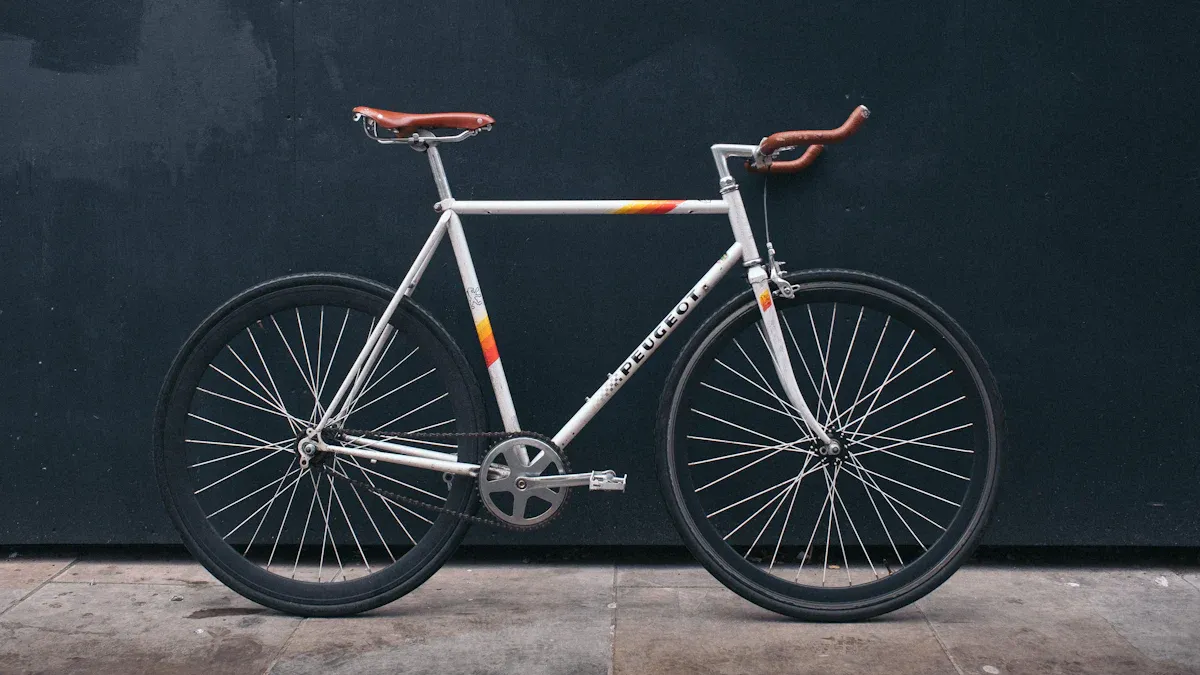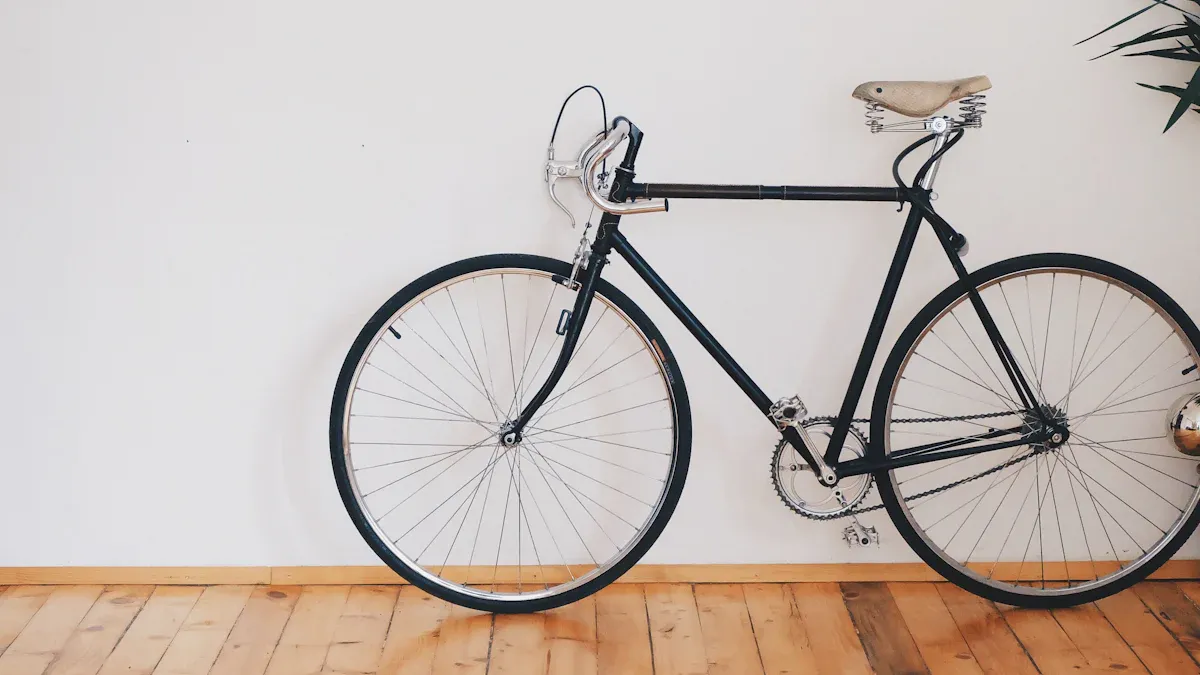
Choosing the right stretch bike frame is crucial for your comfort and performance on the road. A good frame can make all the difference in how enjoyable your ride feels. You’ll want to consider several factors when making your choice, such as size, material, and design. By keeping these elements in mind, you can find the perfect stretch bike frames that suit your needs and enhance your cycling experience.
Key Takeaways
Choose a stretch bike frame size that fits you. This helps you stay comfortable and ride safely.
Pick the right frame material for your riding style. Use aluminum for lightness or steel for smooth rides.
Think about the suspension type for your terrain. Use full suspension for rough trails and hardtail for smooth roads.
Select wheel size and tire type for your paths. This will improve your control and comfort.
Keep your brakes in good shape for safety. This helps you stop smoothly during every ride.
Stretch Bike Frame Size

Choosing the right stretch bike frame size is very important. It affects your comfort and how well you handle the bike. A frame that fits well helps you ride easily without hurting yourself. If the frame is too big or too small, you may feel pain or discomfort while riding. So, how can you find the right size? Let’s explain it simply.
Top Tube Length
The top tube length is a key measurement to think about. This length changes how stretched out you feel when riding. A longer top tube helps you get into a faster position, which is good for speed. But if it’s too long, reaching the handlebars can be hard. A shorter top tube gives you a more upright position, which is better for casual rides.
To check the top tube length, sit on a bike that is similar. Your arms should reach the handlebars easily without stretching too much. If you feel cramped or too stretched, you need a different frame size.
Stack and Reach Measurements
Stack and reach measurements are standard ways to describe bike frame shapes across different brands and models.
Stack measures how high the front of the bike is. It goes from the bottom bracket center to the top center of the head tube. This affects handlebar height and your riding position.
Reach measures how far you will be stretched out while riding. It goes from the bottom bracket center to the top center of the head tube.
These measurements are not changed by seat tube angles or sloping top tubes. This makes them good for comparing bike fits. Different bike types have their own stack and reach values based on how they are used. For example, race bikes usually have lower stack and longer reach for speed, while comfort bikes have higher stack and shorter reach for a relaxed ride. Mountain bikes often have long reach and low stack for better control.
There are no exact numbers for stretch bike frames, but knowing these ideas will help you pick a frame that fits you well.
By focusing on these measurements, you can make sure your stretch bike frame gives you the comfort and performance you want.
Choosing the Right Material

When you pick a stretch bike frame, the material is very important. It affects how your bike feels when you ride. Different materials have special benefits. They can change the weight and quality of your ride. Let’s look at the most common materials used in bike frames and how they affect your cycling.
Material Types
Here are some popular materials for your stretch bike frame:
Aluminum: This light material is loved by many cyclists. It’s strong and doesn’t rust, which is good for all weather. Aluminum frames come in many colors and designs, so you can have a custom look that fits your style.
Steel: Known for being tough, steel frames give a smooth ride. They can soak up bumps better than aluminum. This means you’ll feel more comfortable on rough roads. But, steel frames are usually heavier, so think about that if you want speed.
Titanium: If you want strength and lightness, titanium frames are great. They resist rust and can last a long time. They cost more, but many cyclists think it’s worth it for the comfort and performance.
Carbon Fiber: This material is getting popular for high-performance bikes. Carbon fiber frames are super light and can be shaped for speed. They also reduce vibrations well, giving you a smooth ride. But, they can be more fragile than other materials, so be careful with them.
Impact on Comfort
The material of your bike frame affects your comfort while riding. For example, an aluminum frame might give you a lighter bike that’s easy to handle. But, you might feel more bumps from the road compared to a steel or titanium frame.
On the other hand, a steel frame can absorb shocks better. This makes it great for long rides on bumpy paths. If you want a cruiser frame for easy rides, steel or titanium could be best for you.
In the end, the right material depends on how you ride and what you like. Think about where you will ride and how much comfort is important to you. By choosing the right material, you can make your cycling experience better and enjoy every ride.
Suspension Systems
When it comes to stretch bike frames, suspension systems play a vital role in your overall riding experience. They help absorb shocks from the road, making your ride smoother and more enjoyable. Let’s dive into the different types of suspension and how they can benefit your comfort.
Types of Suspension
There are mainly two types of suspension systems you’ll find on stretch bikes:
Hardtail Suspension: This type features a rigid rear end with no rear suspension. It’s lighter and more efficient for climbing hills. You’ll feel more connected to the bike, which can enhance your control on smooth surfaces.
Full Suspension: This system has both front and rear suspension. It absorbs bumps and rough terrain better than hardtail. If you ride on uneven paths or trails, full suspension can make a big difference in comfort.
Benefits for Comfort
So, how does suspension affect your ride? Here are some key benefits:
Shock Absorption: A good suspension system absorbs shocks from bumps and potholes. This means less jarring for you, leading to a more comfortable ride.
Improved Control: With a full suspension, you’ll have better traction on rough surfaces. This helps you maintain control, especially when navigating tricky trails.
Less Fatigue: Riding on a bike without suspension can tire you out quickly. A well-designed suspension system reduces the impact on your body, allowing you to ride longer without feeling worn out.
Tip: When choosing a bike, consider where you’ll be riding most often. If you plan to tackle rough trails, a full suspension might be the way to go. For smoother rides, a hardtail could be sufficient.
Wheels and Tires
When it comes to your stretch bike, wheels and tires play a big role in how your bike handles and how comfortable your ride feels. Let’s break down what you need to know about wheel size and tire types.
Wheel Size
Wheel size can significantly affect your bike’s handling. Common sizes include 26-inch, 27.5-inch, and 29-inch wheels. Here’s how they differ:
26-inch wheels: These are great for maneuverability. They make it easier to navigate tight turns and technical trails. If you enjoy riding in urban areas or on winding paths, this size might be for you.
27.5-inch wheels: This size offers a balance between speed and control. You get the agility of smaller wheels with some of the stability of larger ones. It’s a popular choice for many riders.
29-inch wheels: These wheels roll over obstacles smoothly. They provide better traction and stability, especially on rough terrain. If you plan to tackle trails or uneven surfaces, consider going with 29-inch wheels.
Choosing the right wheel size can enhance your riding experience. Think about where you’ll ride most often and what feels comfortable for you.
Tire Types
Now, let’s talk about tire types. The right tires can make a huge difference in your comfort level. Here are some common types:
Road Tires: These tires are narrow and smooth. They’re perfect for paved surfaces and help you achieve higher speeds. If you’re mostly riding on roads, these are a solid choice.
Mountain Tires: These tires are wider and have more tread. They grip well on rough terrain and provide stability. If you love off-road adventures, mountain tires are essential.
Hybrid Tires: These tires combine features of both road and mountain tires. They work well on various surfaces, making them versatile for different riding conditions.
Tip: When selecting tires, consider the terrain you’ll be riding on. The right tire can improve your comfort and performance, so choose wisely!
By understanding wheel sizes and tire types, you can make informed decisions that enhance your cycling experience. Happy riding!
Drivetrain Compatibility
When you choose a stretch bike frame, drivetrain compatibility is key. You want to ensure that all components work well together. This includes the gears, shifters, and chain. Let’s break down what you need to know about gear ratios and component compatibility.
Gear Ratios
Gear ratios determine how easy or hard it is to pedal your bike. They affect your speed and how well you climb hills. Here’s how it works:
Low Gear Ratios: These make pedaling easier. They’re great for climbing steep hills or riding slowly. You’ll find low gears helpful when you need to conserve energy.
High Gear Ratios: These require more effort but allow you to go faster on flat surfaces. If you enjoy speed, high gears will help you reach your goals.
To find the right gear ratio, think about where you’ll ride. If you plan to tackle hills, opt for a bike with lower gear ratios. For flat roads, higher ratios will suit you better.
Component Compatibility
Now, let’s talk about component compatibility. Not all parts fit every bike. Here are some tips to ensure everything works together:
Check Compatibility: Look for components that match your bike’s brand and model. This includes the shifters, derailleurs, and cranksets. Mismatched parts can lead to poor performance.
Consider Your Riding Style: If you ride aggressively, you might need more durable components. For casual rides, lighter parts may be sufficient.
Consult Experts: Don’t hesitate to ask for help at your local bike shop. They can guide you in choosing compatible parts that fit your needs.
Tip: Always double-check specifications before purchasing new components. This will save you time and money in the long run!
By understanding gear ratios and ensuring component compatibility, you can create a smooth and enjoyable riding experience. Happy cycling!
Braking Systems
The braking system on your stretch bike is very important for safety and control. You want to be sure your brakes will work when you need them. Let’s look at the different types of brakes and some tips to keep them working well.
Types of Brakes
You usually find two main types of brakes on stretch bikes: mechanical disc brakes and hydraulic disc brakes. Here’s a quick comparison:
Mechanical Disc Brakes: These brakes use cables to work. They are easy to use and maintain. But, they need regular adjustments because of cable stretch and pad wear. If you like fixing your bike, these might be good for you.
Hydraulic Disc Brakes: These brakes use fluid to create pressure. They stop smoother and stronger. Plus, they adjust automatically for pad wear, so they need less maintenance. However, they can be tricky and may need special tools for repairs.
Here’s a handy table to summarize the differences:
Feature | Mechanical Disc Brakes | Hydraulic Disc Brakes |
|---|---|---|
Maintenance Frequency | Needs frequent adjustments due to cable stretch and pad wear | Needs less frequent adjustments due to self-adjusting system |
Maintenance Complexity | Simple, can be done with basic tools | Complex, needs specialized tools and knowledge |
Maintenance Cost | Lower cost due to simpler procedures | Higher cost due to complexity and specialized servicing |
Maintenance Tips
Keeping your brakes in good shape is key for safe riding. Here are some tips to help you care for your braking system:
Regular Inspections: Check your brake pads for wear. If they look thin, it’s time to change them. For mechanical brakes, make sure the cables are tight and not frayed.
Clean Your Brakes: Dirt can affect how well they work. Wipe down your brake parts often to keep them clean.
Adjust as Needed: If your brakes feel soft or don’t respond well, it might be time to adjust them. Mechanical brakes often need cable tension adjustments to work well.
Seek Professional Help: If you have hydraulic brakes, ask a bike shop for help with maintenance. They can assist with tricky tasks like bleeding the system.
Tip: Regular maintenance keeps you safe and helps your braking system last longer. So, make it a habit to check your brakes often!
By knowing the types of brakes and how to maintain them, you can have a safer and more enjoyable ride on your stretch bike. Happy cycling!
Comfort and Ergonomics
When it comes to your stretch bike, comfort and ergonomics are key. You want to enjoy every ride without feeling sore or strained. Let’s dive into two important aspects: seat design and handlebar position.
Seat Design
The seat design can make or break your cycling experience. A well-designed seat supports your body and helps you maintain a good posture. Here are some things to consider:
Padding: Look for a seat with enough padding to keep you comfortable on long rides. Too little padding can lead to discomfort, while too much can make it hard to pedal efficiently.
Shape: Different shapes suit different riders. Some prefer wider seats for more support, while others like narrower ones for better mobility. Test a few options to see what feels best for you.
Adjustability: An adjustable seat allows you to find the perfect height and angle. This flexibility helps you achieve a comfortable riding position, which is essential for long distances.
Handlebar Position
Handlebar position also plays a significant role in your comfort. The right height and angle can reduce strain on your back and shoulders. Here’s how to get it right:
Height: Your handlebars should be at a height that allows you to ride comfortably without hunching over. If they’re too low, you might feel pressure on your wrists and back.
Angle: Adjusting the angle of your handlebars can help you find a more natural grip. A slight upward tilt can relieve pressure on your hands and wrists.
Reach: Make sure you can reach the handlebars without stretching too much. If you feel cramped or too extended, it’s time to adjust.
By focusing on seat design and handlebar position, you can enhance your overall riding experience. Remember, a comfortable bike means more enjoyable rides!
Picking the right stretch bike frame is very important for your comfort and how well you ride. Here are some important things to think about:
Measure your height carefully to find the best frame size.
Know how frame measurements like seat tube length, reach, and stack change your riding position.
Think about how you like to ride. Do you want a relaxed upright position or a sporty stance?
Consider the type of terrain you will ride on and your goals.
By looking at these points, you can make a smart choice that improves your cycling experience. Remember, the right frame can really change how much you enjoy your rides!
FAQ
What size stretch bike frame do I need?
To find the right frame size, measure your height and inseam. Most brands have size charts based on these numbers. A good fit helps you feel comfortable and ride better.
How do I choose the right material for my bike frame?
Think about how you ride and where you go. Aluminum is light, steel is comfy, titanium is strong and light, and carbon fiber is great for speed. Each material changes how your ride feels.
What type of suspension should I choose?
If you ride on smooth roads, a hardtail suspension works well. For bumpy trails, choose full suspension to soak up shocks and make your ride comfy. Your choice depends on where you ride most.
How often should I maintain my bike’s brakes?
Check your brakes often, at least once a month. Look at the pads for wear and clean the parts to keep them working well. Regular care keeps you safe and helps your brakes last longer.
Can I customize my bike’s components?
Yes! You can upgrade parts like gears, tires, and handlebars to fit your style. Just make sure they work with your bike frame. Ask a local bike shop for expert help on the best choices.
